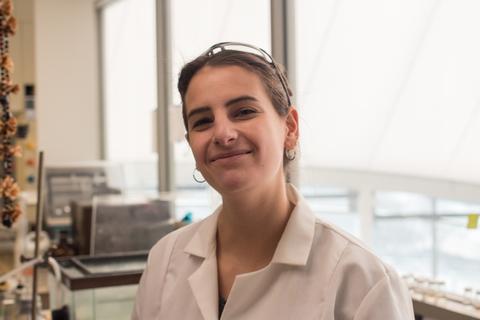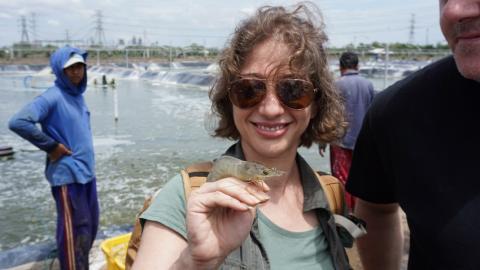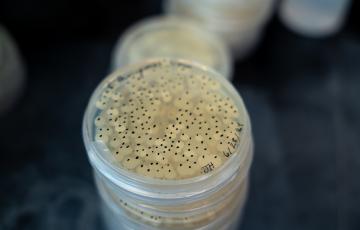Setting up student entrepreneurs for success
From the start, graduate student Lauren Jones knew that she wanted to create a product that harnessed the beneficial qualities of bacteria to solve an environmental issue. Through discussions with her mentors in the Ratcliffe Environmental Entrepreneurs Fellowship (REEF), her idea was refined into Probeeotic, a dry probiotic spray to help the immune systems of bees. This potential remedy could ease the symptoms of colony collapse disorder, a term used to encapsulate all the threats bees face today from the lack biodiversity in their environment to disease.

Jonas is one of six students in the REEF program, created to help young scientists cultivate leadership and business skills necessary to bring their research into commercial markets. The program provides students with an enhanced appreciation of the potential business implications of their research.
“REEF truly changed my life,” said Lauren Jonas upon reflecting on her experience with the REEF program. “I realized that anyone can start a business. It’s really hard and you have to be passionate, but it’s possible and I never would have had this option if I hadn’t taken REEF.”
Established in 2014 at the Institute of Marine and Environmental Technology (IMET) and supported by the Philip E. and Carole R. Ratcliffe Foundation, the REEF program is no small time investment for these full time graduate students. The program runs for eight months, and each month REEF participants dedicated their Friday afternoon and all-day Saturday to the program.
The group meets at IMET in Baltimore for a different module each month, ranging from brainstorming to customer acquisition and copyrights, each aimed at advancing their understanding of starting a business, growing connections in the entrepreneurial industry, and developing their own ideas. Local business leaders such as P.J. Bellomo from BlueSources, Steve Davey of Fiberight, and Dalton Tong from John Hopkins Carey Business School came to speak students about being science entrepreneurs. At the conclusion of the program, students apply their new skills by preparing a final product pitch in front of a judging panel of leading entrepreneurs and investors.
The program helps build skills that are often overlooked in the science field such as intellectual property, budgeting, marketing, strategic communication and idea pitching. While these skills are not directly related to coursework or research, they are fundamental skills for any career and open up a world of opportunity for students.
Institute of Marine and Environmental Technology Assistant Director Nina Lamba leads the REEF Program and helps mentor students throughout the process of product development. "The REEF Program is a great opportunity to build valuable professional skills, whether or not you choose to become an entrepreneur,” she says.
While not all graduates of the REEF program have chosen to continue their entrepreneurial idea developed in the program, several very successful companies have emerged.

Graduate Dr. Suzan Sharestani completed her $600,000 seed funding for her start-up Minnowtech, an aquaculture technology company enabling shrimp farmers to image shrimp abundance. Other businesses include Manta Biofuels, a company that grows and harvests algae to produce a renewable and carbon-neutral crude oil, Blueblood, a startup that will over a sustainable, year-round, high-quality supply of horseshoe crab blood for the biomedical industry, and AlgenAir, a team that developed the world's first natural air purifier that uses algae to remove carbon dioxide from the air and produces oxygen while filtering dust and allergens.
Each year, two awards are presented following the completion of the REEF program: “Most Viable Product” and “Best Presentation.”
This year, the award for “Best Presentation” went to Graduate Research Assistant Morgan Ross from Horn Point Laboratory. In the REEF program, Ross started to develop wearable toxin sensor for Brevetoxin aerosols. Brevetoxin is released into the water and into the air by the harmful algal bloom (HAB) Karenia brevis, also known as the red tide. Her product pitch was inspired by her thesis research on harmful algal blooms and water quality in the coastal waters of Assateague Island.
"I am very grateful to Dr. Nina Lamba and Dr. Russell Hill for organizing the REEF Program and extending the offer to participate to students outside of IMET," says Morgan, "I am also hugely appreciative of the Ratcliffe Foundation for funding the fellowship."
There is a lot of research and management that goes into red tide management and awareness in the water, but there is no easy way to detect Brevetoxin in the air. For the REEF program, her company “Breveazy” proposed a color-changing bracelet that would provide real-time detection of Brevetoxin aerosols. The product would have consisted of a single-use detection strip that could be inserted into a reusable bracelet.
“If three years from now I have another idea for a future business, I now know what to do and how to potentially develop my idea into a potential business,” said Jonas.
Learn more about the REEF Program (https://imet.usmd.edu/reef-program)


